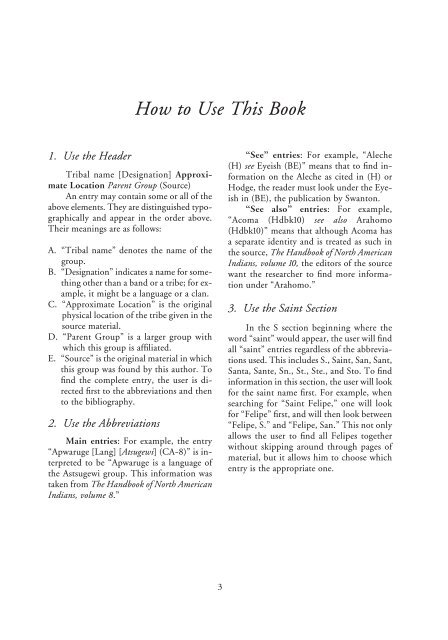Create successful ePaper yourself
Turn your PDF publications into a flip-book with our unique Google optimized e-Paper software.
How to Use This Book<br />
1. Use <strong>the</strong> Header<br />
<strong>Tribal</strong> name [Designation] Approximate<br />
Location Parent Group (Source)<br />
An entry may contain some or all <strong>of</strong> <strong>the</strong><br />
above elements. They are distinguished typographically<br />
and appear in <strong>the</strong> order above.<br />
Their meanings are as follows:<br />
A. “<strong>Tribal</strong> name” denotes <strong>the</strong> name <strong>of</strong> <strong>the</strong><br />
group.<br />
B. “Designation” indicates a name for something<br />
o<strong>the</strong>r than a band or a tribe; for example,<br />
it might be a language or a clan.<br />
C. “Approximate Location” is <strong>the</strong> original<br />
physical location <strong>of</strong> <strong>the</strong> tribe given in <strong>the</strong><br />
source material.<br />
D. “Parent Group” is a larger group with<br />
which this group is affiliated.<br />
E. “Source” is <strong>the</strong> original material in which<br />
this group was found by this author. To<br />
find <strong>the</strong> complete entry, <strong>the</strong> user is directed<br />
first to <strong>the</strong> abbreviations and <strong>the</strong>n<br />
to <strong>the</strong> bibliography.<br />
2. Use <strong>the</strong> Abbreviations<br />
Main entries: For example, <strong>the</strong> entry<br />
“Apwaruge [Lang] [Atsugewi] (CA-8)” is interpreted<br />
to be “Apwaruge is a language <strong>of</strong><br />
<strong>the</strong> Astsugewi group. This information was<br />
taken from The Handbook <strong>of</strong> North American<br />
Indians, volume 8.”<br />
“See” entries: For example, “Aleche<br />
(H) see Eyeish (BE)” means that to find information<br />
on <strong>the</strong> Aleche as cited in (H) or<br />
Hodge, <strong>the</strong> reader must look under <strong>the</strong> Eyeish<br />
in (BE), <strong>the</strong> publication by Swanton.<br />
“See also” entries: For example,<br />
“Acoma (Hdbk10) see also Arahomo<br />
(Hdbk10)” means that although Acoma has<br />
a separate identity and is treated as such in<br />
<strong>the</strong> source, The Handbook <strong>of</strong> North American<br />
Indians, volume 10, <strong>the</strong> editors <strong>of</strong> <strong>the</strong> source<br />
want <strong>the</strong> researcher to find more information<br />
under “Arahomo.”<br />
3. Use <strong>the</strong> Saint Section<br />
In <strong>the</strong> S section beginning where <strong>the</strong><br />
word “saint” would appear, <strong>the</strong> user will find<br />
all “saint” entries regardless <strong>of</strong> <strong>the</strong> abbreviations<br />
used. This includes S., Saint, San, Sant,<br />
Santa, Sante, Sn., St., Ste., and Sto. To find<br />
information in this section, <strong>the</strong> user will look<br />
for <strong>the</strong> saint name first. For example, when<br />
searching for “Saint Felipe,” one will look<br />
for “Felipe” first, and will <strong>the</strong>n look between<br />
“Felipe, S.” and “Felipe, San.” This not only<br />
allows <strong>the</strong> user to find all Felipes toge<strong>the</strong>r<br />
without skipping around through pages <strong>of</strong><br />
material, but it allows him to choose which<br />
entry is <strong>the</strong> appropriate one.<br />
3


















